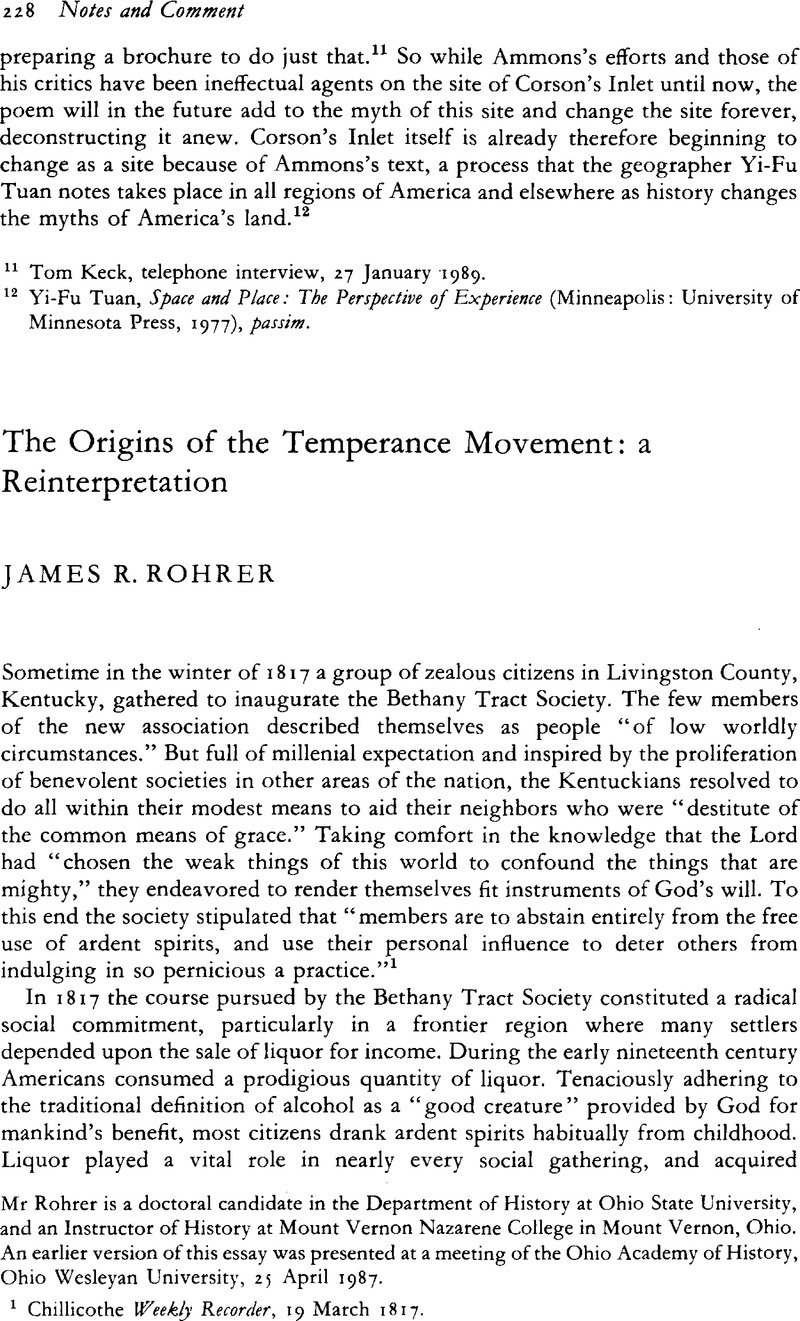Published online by Cambridge University Press: 16 January 2009

1 Chillicothe, Weekly Recorder, 19 03 1817.Google Scholar
2 Rorabaugh, William J., The Alcoholic Republic: An American Tradition (New York, 1979), especially 5–21, 77–82, 151–55.Google Scholar
3 Dannenbaum, Jed, Drink and Disorder: Temperance Reform in Cincinnati from the Washington Revival to the WCTU (Urbana, 1984), 16–19Google Scholar; Hampel, Robert L., Temperance and Prohibition in Massachusetts, 1813–1852 (Ann Arbor, 1982), 25–35Google Scholar; Meyer, Paul, “The Transformation of American Temperance: The Popularization and Radicalization of a Reform Movement, 1813–1860,” Ph.D., University of Iowa, 1976, pp. 63–64, 78–80Google Scholar; Tyrrell, Ian, Sobering Up: From Temperance to Prohibition in Antebellum America, 1800–1860 (Westport, CN, 1979), 54–55.Google Scholar
4 A Summary of Christian Doctrine and Practice … (Hartford, 1804), 49Google Scholar; Ohio Republican, 6 03 1815Google Scholar; Western Herald, 22 06 1815Google Scholar; Weekly Recorder, 17 07 1816Google Scholar. Finley, James B., Autobiography of Rev. James B.Finley, (Cincinnati, 1853), 249–50Google Scholar discusses temperance among western Methodists during the 1810s. On Quaker reform see the Minutes of the Ohio Yearly Meeting, 1813–1821, Ohio Society of Friends Records, Box 1, Ohio Historical Society, Columbus, Ohio. Also see The Religious Museum, 22 07 1818.Google Scholar
5 Keller, Charles R., The Second Great Awakening in Connecticut (New Haven, 1942), 141–42Google Scholar; Bacon, Nathaniel, ed. Contribution to the Ecclesiastical History of Connecticut (New Haven, 1861), 203–208, 302, 314.Google Scholar
6 Intemperance: An Address to the Churches and Congregations of the Western District of Fairfield Country, Connecticut (Hartford, 1812), 25–26.Google Scholar
7 Keller, , Second Great Awakening, 141–42Google Scholar. The resolutions were widely circulated in tract form and appeared in evangelical newspapers throughout the nation during the following decade. See, for example, The Evangelical Record (Lexington, Kentucky), 14 10 1812Google Scholar; The Weekly Recorder, 20 09 1815.Google Scholar
8 Connecticut Evangelical Magazine, 6, 8 (08 1813), 297–99Google Scholar; Seward, John to Flint, Abel, 10 08 1812Google Scholar, Connecticut Missionary Society papers (hereafter cited CMS papers), Congregational House, Hartford, Connecticut; Leslie, Jonathan to Flint, Abel, 25 10 1814Google Scholar, CMS papers; Cowles, Giles to Flint, Abel, 28 08 1815Google Scholar, CMS papers; Coe, Alvan to Flint, Abel, 9 09 1817, CMS papers.Google Scholar
9 Records of the Synod of Pittsburgh … (Pittsburgh, 1852), 121, 132Google Scholar; Weekly Recorder, 11 07 1915, 24 10 1816, 18 06 1817Google Scholar. Thomas's comments on Gilliland's church can be found on p. 8 of his unpublished journal. See Journal of Thomas Thomas, Vol. 1127, Ohio Historical Society, Columbus, Ohio.
10 Weekly Recorder, 10, 17 08 1820.Google Scholar
11 Leslie, Jonathan to Flint, Abel, 25 10 1814Google Scholar, CMS papers; Address of the Chillicothe Association for Promoting Morality and Good Order, to their Fellow Citizens… (Chillicothe, Ohio, 1815), 5Google Scholar; Weekly Recorder, 2 03 1815Google Scholar; Ohio Republican, 6 03 1815.Google Scholar
12 Emerson's address was printed by Andrews in the Weekly Recorder, 20 12 1814.Google Scholar
13 Ibid. This theme emerges in every primary source consulted.
14 Meyer, , “The Transformation of American Temperance,” 15Google Scholar; Tyrrell, , Sobering Up, 33–53.Google Scholar
15 The best study of the MSSI is Hampel's, Temperance and Prohibition in Massachusetts, especially 11–24Google Scholar. See also Tyrrell, , Sobering Up, 33–53.Google Scholar
16 Nettleton first clearly tied abstinence to conversion in 1822. After 1826 his views were reprinted widely by evangelical editors. See, for example, Western Intelligencer, 12 03 1829.Google Scholar
17 On the emergence of temperance in the Western Reserve see Rohrer, James R., “Battling the Master Vice: The Evangelical War Against Intemperance in Ohio, 1800–1832,” M.A., The Ohio State University, 1985, 81–105.Google Scholar